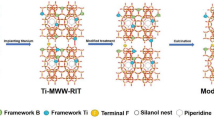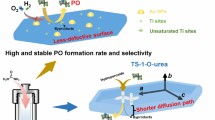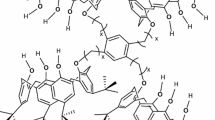Abstract
The borosilicate zeolite ERB-1 with an MWW layer structure was deboronated and loaded with titanium by the atom planting method with TiCl4 vapor. The generated Ti-ERB-1 contains four-coordinate framework titanium species and shows higher activity for the reaction of large molecules in the zeolite for epoxidation in a nonpolar environment with cup-like hemi-cages and supercages containing 12-membered rings in the MWW structure. By comparing the cyclohexanone ammoximation and alkene epoxidation activities, the influence of the polarities of Ti-ERB-1, TS-1 and Ti-MWW on the catalytic activity in environments of differing polarities was explored. Then, the polarity of Ti-ERB-1 was modified by grafting silicon onto the surface via SiCl4 or trimethylchlorosilane and additional hydrothermal treatment with piperidine to decrease the hydrophilicity of the hydroxyl group in the deboronated ERB-1. The catalytic results of 1-hexene, cyclohexene, cyclooctene epoxidation and cyclohexanone ammoximation show that the successfully hydrophobically modified Ti-ERB-1 has significantly improved catalytic activity in aqueous solution and in the presence of H2O2 oxidant. The modified zeolite catalyst can decrease the adsorption of H2O molecules on the zeolite and increase the H2O2 efficiency during the epoxidation of organic alkene and cycloalkene molecules, even in polar solvents.
Graphical Abstract







Similar content being viewed by others
References
Xia C, Lin M, Zheng A, Xiang Y, Zhu B, Xu G, Shu X (2016) Irreversible deactivation of hollow TS-1 zeolite caused by the formation of acidic amorphous TiO2-SiO2 nanoparticles in a commercial cyclohexanone ammoximation process. J Catal 338:340–348
Zhang F, Guo X, Wang X, Li G, Zhou J, Yu J (2001) The active sites in different TS-1 zeolites for propylene epoxidation studied by ultraviolet resonance Raman and ultraviolet visible absorption spectroscopies. Catal Lett 72:235–239
Perego C, Carati A, Ingallina P, Mantegazza MA, Bellussi G (2001) Production of titanium containing molecular sieves and their application in catalysis. Appl Catal A 221:63–72
Khouw CB, Li HX, Dartt CB, Davis ME (1993) Selective oxidation of alkanes, alkenes, and phenol with aqueous H2O2 on titanium silicate molecular sieves. ACS Symp Ser 523:273–280
Wang T, Jin F, Yi X, Wu G, Zheng A, Atom-planting synthesis of MCM-36 catalyst to investigate the influence of pore structure and titanium coordination state on epoxidation activity, (2021) Microporous Mesoporous Mater 310:110645
Yoshioka M, Yokoi T, Tatsumi T (2014) Effectiveness of the reversible structural conversion of MWW zeolite for preparation of interlayer-expanded Ti-MWW with high catalytic performance in olefin epoxidation. Microporous Mesoporous Mater 200:11–18
Moliner M, Corma A (2012) Synthesis of expanded titanosilicate MWW-related materials from a pure silica precursor. Chem Mater 24:4371–4375
Leonowicz ME, Lawton JA, Lawton SL, Rubin MK (1994) MCM-22: a molecular sieve with two independent multidimensional channel systems. Science 264:1910–1913
Wu P, Tatsumi T, Komatsu T, Yashima T (2000) Hydrothermal synthesis of a novel titanosilicate with MWW topology. Chem Lett 29:774–775
Corma A, Fornés V, Guil JM, Pergher S, Maesen TLM, Buglass JG (2000) Preparation, characterisation and catalytic activity of ITQ-2, a delaminated zeolite. Microporous Mesoporous Mater 38:301–309
Corma A, Diaz U, Fornés V, Guil JM, Martínez-Triguero J, Creyghton EJ (2000) Characterization and catalytic activity of MCM-22 and MCM-56 compared with ITQ-2. J Catal 191:218–224
Chang C, Jin F, Jang L, Lee J, Cheng S (2016) Effect of the grafting agent on the structure and catalytic performance of Ti-MCM-22. Catal Sci Technol 6:7631–7642
Jin F, Chen S, Jang L, Lee J, Cheng S (2014) New Ti-incorporated MCM-36 as an efficient epoxidation catalyst prepared by pillaring MCM-22 layers with titanosilicate. J Catal 319:247–257
Jin F, Chang C, Yang C, Lee J, Jang L, Cheng S (2015) New mesoporous titanosilicate MCM-36 material synthesized by pillaring layered ERB-1 precursor. J Mater Chem A 3:8715–8724
Corma A, Esteve P, Martınez A (1996) Solvent effects during the oxidation of olefins and alcohols with hydrogen peroxide on Ti-Beta catalyst: the influence of the hydrophilicity-hydrophobicity of the zeolite. J Catal 161:11–19
Fan W, Wu P, Tatsumi T (2008) Unique solvent effect of microporous crystalline titanosilicates in the oxidation of 1-hexene and cyclohexene. J Catal 256:62–73
Wu LZ, Tang ZM, Yu YK, Yao XT, Liu W, Li L, Yan BH, Liu YM, He MY (2018) Facile synthesis of a high-performance titanosilicate catalyst with controllable defective Ti(OSi)3OH sites. Chem Commun 54:6384–6387
Srinivas D, Manikandan P, Laha SC, Kumar R, Ratnasamy P (2003) Reactive oxo-titanium species in titanosilicate molecular sieves: EPR investigations and structure–activity correlations. J Catal 217:160–171
Wilde N, Pelz M, Gebhardt SG, Gläser R (2015) Highly efficient nano-sized TS-1 with micro-/mesoporosity from desilication and recrystallization for the epoxidation of biodiesel with H2O2. Green Chem 17:3378–3389
Beyer HK, Belenykaja IM, Hange F, Tielen M, Grobet PJ, Jacobs PA (1985) Preparation of high-silica faujasites by treatment with silicon tetrachloride. J Chem Soc Faraday Trans 81:2889–2901
Sulikowski B, Borbely G, Beyer HK, Karge HG, Mishin IW (1989) Improved method for dealumination of faujasite-type zeolites with sllicon tetrachloride. J Phys Chem 93:3240–3243
Najar H, Zina MS, Ghorbel A (2010) Study of the effect of the acid dealumination on the physico-chemical properties of Y zeolite. React Kinet Mech Catal 100:385–398
Su L, Liu L, Zhuang J, Wang H, Li Y, Shen W, Xu Y, Bao X (2003) Creating mesopores in ZSM-5 zeolite by alkali treatment: a new way to enhance the catalytic performance of methane dehydroaromatization on Mo/HZSM-5 catalysts. Catal Lett 91:155–167
Shang Y, Yang P, Jia M, Zhang W, Wu T (2008) Modification of MCM-22 zeolites with silylation agents: acid properties and catalytic performance for the skeletal isomerization of n-butene. Catal Commun 9:907–912
Jiang T, Huang Q, Li Y, Fang M, Zhao Q (2018) Catalytic performance of strong acid catalyst: Methyl modified SBA-15 loaded perfluorinated sulfonic acid obtained by the waste perfluorinated sulfonic acid ion exchange membrane. J Solid State Chem 258:602–609
Millini R, Perego G, Parker WO, Bellussi G, Carluccio L (1995) Layered structure of ERB-1 microporous borosilicate precursor and its intercalation properties towards polar molecules. Microporous Mater 4:221–230
Yan M, Jin F, Ding Y, Wu G, Chen R, Wang L, Yan Y (2019) Synthesis of titanium-incorporated MWW zeolite by sequential deboronation and atom-planting treatment of ERB-1 as an epoxidation catalyst. Ind Eng Chem Res 58:4764–4773
Maijanen A, Derouane EG, Nagy JB (1994) FT-IR and solid-state NMR investigation of surface hydroxyl groups on dealuminated ZSM-5. Appl Surf Sci 75:204–212
Jin F, Huang SJ, Cheng SF, Wu YX, Chang CC, Huang YW (2015) The influences of Al species and Ti species on the catalytic epoxidation over Si/Ti-pillared MCM-36 synthesized from MCM-22. Catal Sci Technol 5:3007–3016
Acknowledgements
This work was preliminarily supported by the Open Project of Key Laboratory of Green Chemical Engineering Process of Ministry of Education [Grant Number GCP20190204], Engineering Research Center of Phosphorus Resources Development and Utilization of Ministry of Education [Grant Number LKF201908], and Hubei key Laboratory of Novel Reactor and Green Chemistry Technology (Wuhan Institute of Technology) [Grant Number 40201005].
Author information
Authors and Affiliations
Corresponding author
Additional information
Publisher's Note
Springer Nature remains neutral with regard to jurisdictional claims in published maps and institutional affiliations.
Rights and permissions
About this article
Cite this article
Xu, Y., Jin, F., Wu, G. et al. Effect of Surface Polarity of Titanium-Loaded ERB-1 Catalyst on Epoxidation and Ammoximation. Catal Lett 153, 260–270 (2023). https://doi.org/10.1007/s10562-022-03954-z
Received:
Accepted:
Published:
Issue Date:
DOI: https://doi.org/10.1007/s10562-022-03954-z




